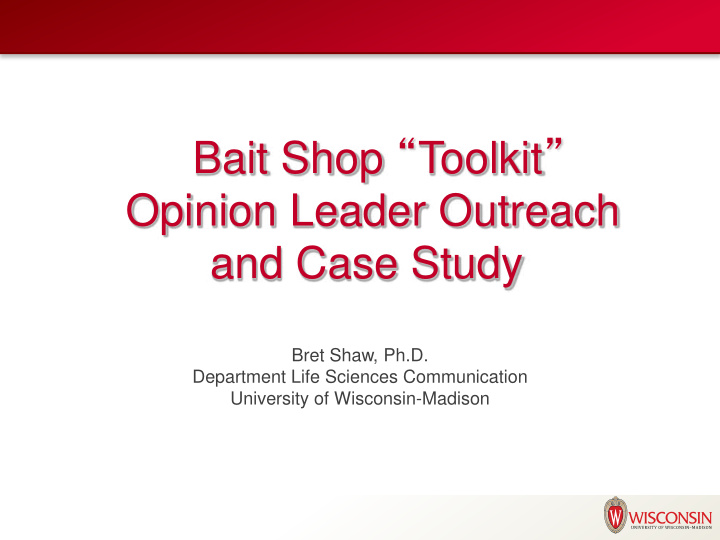



Bait Shop “ Toolkit ” Opinion Leader Outreach and Case Study Bret Shaw, Ph.D. Department Life Sciences Communication University of Wisconsin-Madison
The Problem Aquatic Invasive Species (AIS) are non-native plants and animals that can harm native ecosystems AIS can attach themselves to fishing and boating equipment and spread from lake to lake Communicating AIS-prevention information to transient boaters and anglers is important to reduce the spread The challenge: Encouraging behavior change through mediated and interpersonal communication
Mediated Communication Mass Knowledge gain communication Interpersonal Attitude change communication
Two Step Flow of Information MEDIA = Opinion leaders = Individuals in contact with opinion leaders
Bait Shops as Opinion Leaders? 2010 Survey of Bait Shops identified opportunities for engagement 71% agreed or strongly agreed they can play an important role in prevention of AIS and VHS 74% display educational materials about VHS or AIS
Bait Shop Case Study
Challenges Uncertainty about issue Lack of self-efficacy Time
Opportunities Bait shop owners willing to help Point of sale is prime opportunity to share information Customers appreciate giveaways
Social Marketing Defined Promotes voluntary behavior by: Offering desired benefits Reducing barriers Using persuasion to motivate participation
Bait Shop Toolkit Provides bait shops with “ tools ” based on social marketing strategies Prompts Creating effective messages Encouraging commitment
Floating Key Chains
Bait Bucket Stickers �
Trailer Stickers
“ Bait shops in the Spooner area recognize the importance of working together to keep invasive species under control and will be working to share that message with their customers. ”
Evaluation of Toolkit Survey of bait shop owners and statewide AIS coordinators Included questions about Awareness/knowledge Outreach efforts Participation in prevention initiative
AIS Prevention Activities Most bait shops currently engage in some type of AIS prevention activity “ Passive ” activities most common Owners and employees least likely to engage customers in one-on-one conversations
AIS Prevention Activities
AIS Prevention Initiative 80% engaged in some type of AIS outreach 60% knew they participated in AIS prevention Initiative 66% know their professional contact for AIS Increases awareness and self-efficacy
Empowering Bait Shops Bait shop owners who participated in prevention initiative were more likely to feel they are: Knowledgeable about risks of AIS Anglers care what they have to say about topic of AIS
Self-efficacy
Predictors of Outreach Social Norms: Increased pressure from social networks positively correlated with willingness to engage in outreach activities Perceived knowledge: Higher levels of perceived knowledge about AIS can improve self-efficacy
Popular toolkit items Brochures* Bait bucket stickers Floating key chains *Brochures varied around the state
Toolkit items
Two-sided AIS Brochure
Stop Aquatic Hitchhikers! Brochure
Floating key chains 48% displayed key chains Well-received by customers Improve quality in future
Bait bucket stickers 57% used one or both stickers Well-received by customers and bait shops Simple messages are preferred � �
Summary Bait shop owners more likely to engage in “ passive ” activities than “ active ” ones Contact with AIS coordinator or Extension agent can enhance self efficacy and willingness to educate customers
Summary Bait shop owners like informational materials that are simple and straightforward Prompts like floating key chains and bait bucket stickers well received Bait shops appreciate being recognized for their efforts
Recommend
More recommend